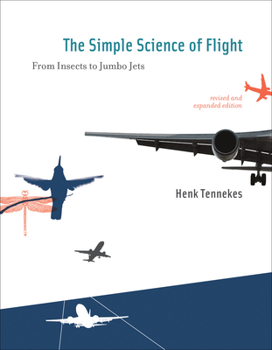The Simple Science of Flight: From Insects to Jumbo Jets
Select Format
Select Condition 
Book Overview
An investigation into how machines and living creatures fly, and of the similarities between butterflies and Boeings, paper airplanes and plovers. From the smallest gnat to the largest aircraft, all things that fly obey the same aerodynamic principles. In The Simple Science of Flight, Henk Tennekes investigates just how machines and creatures fly: what size wings they need, how much energy is required for their journeys, how they cross...
Format:Paperback
Language:English
ISBN:0262513137
ISBN13:9780262513135
Release Date:September 2009
Publisher:MIT Press
Length:216 Pages
Weight:0.80 lbs.
Dimensions:0.6" x 7.1" x 8.9"
Age Range:18 years and up
Grade Range:Postsecondary and higher
Customer Reviews
5 ratings
The science of flight made simple
Published by Thriftbooks.com User , 19 years ago
General readers interested in learning the basics behind the physics of flying won't need to look any further than this slim volume from Prof. Henk Tennekes. In addition to being a fine introduction to how things fly, the book is a quick and easy read at only 130-odd pages. The book's final chapter, devoted to the Boeing 747 and its competitors, makes a compelling argument that the 747 is the most most efficient and well engineered plane in history.
More comprehensible? Impossible.
Published by Thriftbooks.com User , 19 years ago
Since years I love the aviation, only for curiosity I bought this book, and in one morning I've enjoyed too much and learnt a lot about aerodynamics, fuel consumption, the migration of birds(really interesting), the forces in skating! etc. It is a book with of 120 pages really educative and comprenhensible, all questions I made in my mind reading the book were answered a few pages ahead. If you are interested in planes, want to know how simple they fly, even loose the fear, and learn all this in easy way and learn about more things you never thought in relation with planes, this is your book. Is any commision for me??hahaha. Enjoy it.
Fun and instructive
Published by Thriftbooks.com User , 20 years ago
This delightful little book is an introduction to some major aspects of flight. Not all of them. There isn't much on strength of materials, for example. This book concentrates on the fundamental issues of how much power it takes to fly and what size a flying machine ought to be to make optimal use of its power. What makes the book so much fun is the inclusion of flight characteristics of birds and insects. Tennekes starts with a chart of weight versus cruising speed for the insects, birds, and planes. Next, he discusses wing sizes. Then fuel consumption, strategies for takeoffs and landings, and gliding. The author concludes with some praise for the design of the Boeing 747. All commercial passenger planes are best off flying as fast as possible without getting too near the speed of sound, so Mach 0.9 is best. These planes are best off flying high enough to take advantage of the cooler air and good weather: a height of 10 kilometers is ideal. To match the cruising speed with the optimal wing loading at that height, one gets an airplane which is roughly the size and shape of a Boeing 747. I highly recommend this book.
An exciting book about how things fly
Published by Thriftbooks.com User , 25 years ago
This a fascinating look at how things fly. Insects, birds and airplanes all obey the same aerodynamic principles. With a few simple equations and copious examples the author explains lift, drag, wing loading, cruising speed and other aerodynamic concepts.His descriptions of how birds fly, how much energy their flight requires and how they meet the challenge is as exciting as any adventure story. We learn that the pectoral muscles of birds can metabolize fats directly(Human muscles burn sugars which the liver must first convert from fat). But flying is hard work. After 12 hours of cruising a migrating swan will clock 650 miles and lose more than a kilogram of body weight. Thus the importance of bird sanctuaries. Migrating birds must feed to continue their journies.Moving on to airplanes we learn that the Concorde uses 70 tons of kerosene to cross the ocean carrying 100 passengers. The 747 uses the same amount of fuel but carries 350 people and 30 tons of freight. This book explains why.This book is filled with fascinating facts about flight, but charts, tables and illustrations tie them all together. There are a few equations but they are there to enlighten. The author doesn't overwhelm you with mathematics. This book is a must read.
The Gem of Aeronautical literature
Published by Thriftbooks.com User , 25 years ago
This book is definately the most outstanding source for basic aeronautical science. The author's unique perspective, looking at a 747 as compared to a budgy, is a tremendous help in explaining various concepts, from finesse to fuel economy. Although it is not an intense calculus based textbook, it does a great job of making you understand how and why things occur.Mr. Tennekes analogies between birds and aircraft will make you realize the commanality of the two previously distinct subjects. I strongly believe that no one, or at least not many, ar above this book. With everything from sailplanes to skating, supersonic flight to hovering explained, this book should appeal to anyone remotely interested in the subject.





